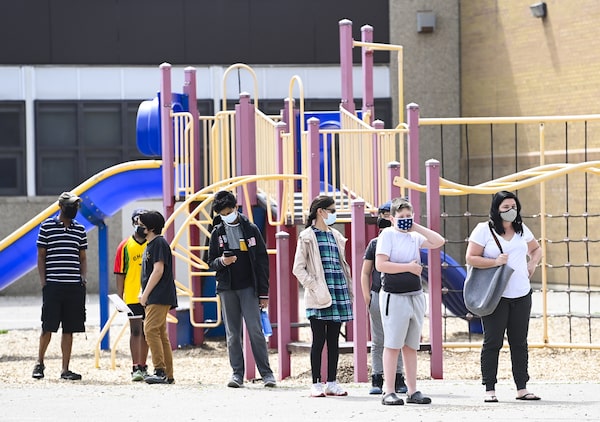
Families and youth aged 12 and older line up for a COVID-19 vaccine at Gordon A Brown Middle School in Toronto on May 19, 2021.Nathan Denette/The Canadian Press
As parts of the country emerge from the third wave of COVID-19 and with slightly more than a month left in the academic year, provinces are taking divergent approaches to reopening schools: Ontario has not ruled out reopening; Nova Scotia has closed for the rest of the academic year; and almost all Alberta students will return to the classroom next week.
The differing plans for how students would end an academic year that has been plagued with disruptions comes as Ontario’s science advisory table found reopening classrooms could lead to as much as an 11-per-cent increase in infections, which it said was manageable. At the same time, doctors and educators are increasingly worried about the mental health and well-being of children, as well as learning gaps associated with school closings.
“Considering all the harm that we’ve seen in our children and especially among families in less privileged situations … I think it would be really important to reopen,” said Peter Juni, scientific director of Ontario’s science advisory table and a professor of medicine and epidemiology at the University of Toronto. “It doesn’t mean we can take it lightly.”
Dr. Juni shared preliminary findings of genetic sequencing from eight Toronto schools that showed transmission of COVID-19 was limited and typically resulted in small clusters. He said outbreaks were limited because of classroom groupings and masking.
The role that schools play in the transmission of the virus remains an evolving picture, and what makes findings even more complex is that jurisdictions have implemented different safety measures in their school buildings. It is clear that school-age children, as a group, tend to be less affected by COVID-19 than adults, but it is far more difficult to determine whether children are less likely to transmit the virus.
Ontario’s ‘slow and cautious’ COVID-19 reopening plan tied to vaccination rates, premier says
B.C. opens COVID-19 vaccine clinics to youth
In Ontario, Premier Doug Ford told reporters earlier this week that there was no consensus among doctors on reopening schools, and that he did not want to risk the increased cases, even as there are growing calls for schools to be reopened in regions with few cases. Last month, the government closed schools across the province indefinitely and moved students to online learning.
Jasmine Flemming, a spokeswoman for Nova Scotia’s education minister, Derek Mombourquette, said the decision made this week to close all schools in that province to in-person learning, and not just in hot spots, was because the variants have moved more quickly between communities. On Friday, Ms. Flemming said the government was taking a more “cautious approach,” adding, “Currently we need to control movement in order to reduce COVID.”
Quebec has kept most schools open to in-person learning through most of the school year. A handful of schools that were closed in the province’s most-affected zones will reopen to in-person learning this coming week.
The determination to stay open has come at a cost, however: About 23,000 Quebec schoolchildren have tested positive for COVID-19 since the pandemic began, along with 3,900 school staff. And those numbers may only be the tip of the iceberg.
New data released this week from a study following 1,632 Montreal daycare, primary- and secondary-school children through the school year showed 8.9 per cent of them had antibodies to SARS-CoV-2 between February and April – nearly three times the rate of six months earlier. About 82 per cent of the children with antibodies had either tested negative or never been tested because they had no symptoms.
Among the 18 per cent who had tested positive previously, two children required hospital care.
“It shows that while children get infected, the vast majority do not have severe clinical symptoms,” said Dr. Kate Zinszer, an epidemiologist and professor of public health at the University of Montreal who is leading the research. “The information is supportive of schools being open.”
Still, Andrew Morris, an infectious-disease physician at Toronto’s University Health Network, said the science is “complicated” on schools and transmission. What doctors do know, he said, is that if there’s a lot of people being infected with COVID-19 in the community, there will also be a fair amount of the virus in schools.
“Whether or not there’s a lot of transmission in schools, it’s really hard to know,” he said, adding that reopening schools, or keeping them open, are tricky decisions for provincial governments.
“School alone, that won’t be an issue. But would the government be willing to say [they’re] going to open up school regionally – but nothing else regionally? That’s the issue. If they open up shopping and dining and all that other stuff regionally [at the same time], that’s where we can run into trouble,” Dr. Morris said.
Anna Banerji, a pediatric infectious-disease expert and associate professor at the University of Toronto’s faculty of medicine, disagrees with suggestions that schools be reopened in Ontario for the remainder of the academic year. She notes that testing children for COVID-19 slowed down in many parts of the country soon after the fall reopening, and only recently ramped up again.
The number of cases among children are “underestimated,” Dr. Banerji said, adding she believes it would be safer to hold off on reopening schools until more people, including those 12 and older, are vaccinated.
“There is a lot more COVID related to school than the data shows,” Dr. Banerji said. “I think there’s a lot of denial on the role of kids in the pandemic.”
Our Morning Update and Evening Update newsletters are written by Globe editors, giving you a concise summary of the day’s most important headlines. Sign up today.
 Caroline Alphonso
Caroline Alphonso Les Perreaux
Les Perreaux